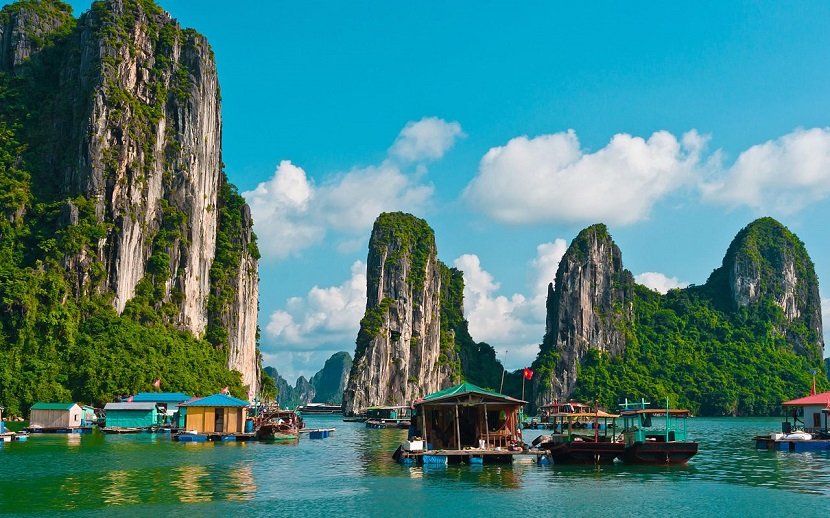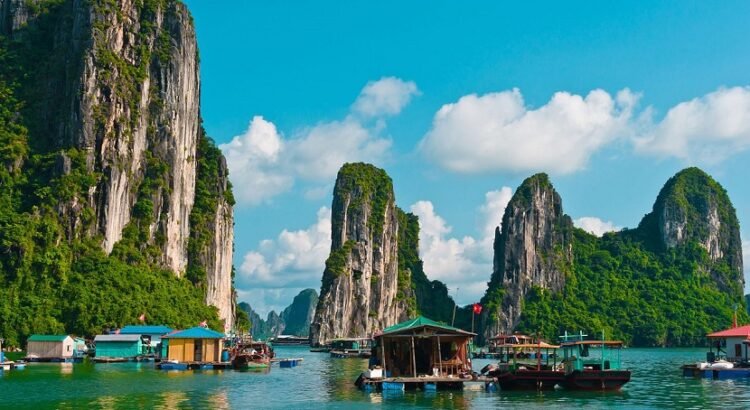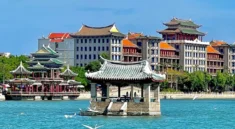
Vietnam is a country where the past and present blend seamlessly, creating a rich cultural mosaic and unforgettable travel experience. Stretching along the eastern edge of the Indochinese Peninsula, Vietnam is a land of stunning contrasts: from timeless cities steeped in history to vibrant street food scenes and surreal natural landscapes like Ha Long Bay. To dive into Vietnam is to immerse yourself in a sensory journey—where ancient temples stand beside modern cafés, where the aroma of sizzling noodles fills every street corner, and where limestone islands rise majestically from emerald waters. Whether you’re a cultural explorer, food lover, or nature enthusiast, Vietnam offers a dynamic and deeply rewarding adventure.
The Historic Cities: A Journey Through Time
Vietnam’s historic cities are the heart of its identity. From imperial citadels and colonial architecture to war memorials and traditional markets, each city tells a story of resilience, heritage, and transformation.
Hanoi: The Timeless Capital
Hanoi, the capital of Vietnam, is a city where time seems to stand still. Founded over a thousand years ago, it has been shaped by Chinese, French, and Soviet influences, all of which are still visible in its architecture and culture. The Old Quarter is a labyrinth of narrow alleys, each named after the goods traditionally sold there—Silver Street, Paper Street, Herbal Medicine Street—offering a glimpse into the city’s mercantile past.
The iconic Hoan Kiem Lake, with its legendary turtle tower, provides a serene escape amidst the bustling traffic. Nearby, the Temple of Literature, Vietnam’s first national university, stands as a symbol of the country’s deep respect for learning and Confucian values.
Don’t miss the Ho Chi Minh Mausoleum, where the revered leader’s body rests. His legacy continues to shape modern Vietnam, and visiting his final resting place is both a cultural and emotional experience.
Hue: The Imperial Legacy
In central Vietnam lies Hue, the former imperial capital of the Nguyen Dynasty. The city is famed for its UNESCO World Heritage-listed Imperial Citadel, a sprawling complex of palaces, temples, walls, and gates that once housed emperors and royal families. Walking through the citadel is like stepping into the pages of Vietnamese history.
Hue is also home to ornate royal tombs, including that of Emperor Khai Dinh, whose mausoleum blends Eastern and Western architectural elements. The Thien Mu Pagoda, perched beside the Perfume River, adds spiritual depth to the city’s cultural offerings.
Unlike the fast pace of Hanoi or Ho Chi Minh City, Hue moves slowly, inviting travelers to linger longer and absorb the elegance of Vietnam’s royal past.
Hoi An: The Living Museum
Just a short journey from Hue is Hoi An, a beautifully preserved trading port that dates back to the 15th century. Recognized by UNESCO for its architectural heritage, Hoi An is a picturesque town of lantern-lit streets, colorful temples, and riverside cafés. The Japanese Covered Bridge, ancient assembly halls, and Chinese shop-houses create a unique aesthetic fusion reflecting the town’s multicultural history.
At night, the town comes alive with the glow of silk lanterns, floating candles on the river, and local musicians playing traditional tunes. The weekly Lantern Festival transforms the town into a magical realm where time feels suspended.
Hoi An is also famous for its tailor shops—perfect for having custom clothing made—and for its thriving art and craft scene, where you can try your hand at lantern-making or Vietnamese calligraphy.
Vietnam’s Legendary Street Food: A Culinary Wonderland
Vietnamese cuisine is one of the world’s most beloved and healthy food traditions. It’s fresh, fragrant, and full of flavor, and the best way to experience it is on the street—where locals gather for morning noodles, midday snacks, and late-night grilled treats. Street food in Vietnam is not just food—it’s culture, history, and identity served on a plate.
Pho: The National Treasure
Perhaps the most iconic Vietnamese dish is pho, a steaming bowl of rice noodles in beef or chicken broth, garnished with herbs, lime, and chili. While it’s available everywhere, Hanoi is considered the birthplace of pho. Early mornings in Hanoi often begin with the aroma of broth simmering in corner stalls, drawing both locals and tourists for breakfast.
Banh Mi: East Meets West
Another street food favorite is the banh mi, a Vietnamese baguette sandwich that reflects the French colonial influence. Filled with pâté, pickled vegetables, grilled meats, and fresh herbs, banh mi is the ultimate fusion of flavors and textures. Each region offers its variation, and no two banh mi are ever quite the same.
Bun Cha and Bun Bo Hue
In the north, bun cha—grilled pork served with rice noodles and a tangy dipping sauce—is a staple. Former U.S. President Barack Obama famously enjoyed bun cha in Hanoi with chef Anthony Bourdain, highlighting its global appeal.
In the central region, bun bo Hue offers a spicy, lemongrass-infused beef noodle soup that embodies the complexity of Vietnamese flavors. Rich, aromatic, and deeply satisfying, it’s a must-try for adventurous eaters.
Fresh Spring Rolls and Street BBQ
Vietnamese spring rolls, or goi cuon, are translucent rolls of rice paper stuffed with shrimp, pork, vermicelli, and herbs—served with peanut or hoisin sauce. They’re light, healthy, and endlessly refreshing.
Street-side barbecue is another local favorite. Tiny plastic stools and charcoal grills dot the sidewalks, where skewers of marinated meat, corn, and seafood are grilled to perfection. Eating on the street is a communal affair, bringing people together over shared plates and laughter.
Sweet Treats and Drinks
Vietnam’s sweet delights are just as varied. Try che, a colorful dessert soup made from beans, jellies, and coconut milk, or banh flan, a caramel custard with Vietnamese coffee twist. Speaking of coffee, ca phe sua da—strong black coffee with sweetened condensed milk served over ice—is a Vietnamese essential. In Hanoi, don’t miss egg coffee, a creamy concoction that’s surprisingly delightful.
Ha Long Bay: Nature’s Masterpiece
No journey through Vietnam is complete without witnessing the ethereal beauty of Ha Long Bay, located in the Gulf of Tonkin in the northeastern part of the country. With nearly 2,000 limestone islands and islets rising from jade-green waters, Ha Long Bay is a UNESCO World Heritage Site and one of the most breathtaking natural landscapes on Earth.
Cruising Through The Karsts
The best way to explore Ha Long Bay is aboard a traditional wooden junk boat. Multi-day cruises offer the chance to sail through hidden coves, visit floating fishing villages, and relax under the starlit sky. The scenery is otherworldly—towering cliffs, misty mornings, and secluded beaches make the bay a photographer’s dream.
More adventurous travelers can explore the bay by kayak, navigating between rock formations and discovering hidden lagoons. Some of the islands have caves, like Sung Sot (Surprise Cave) and Thien Cung (Heavenly Palace Cave), filled with stalactites and stalagmites shaped by centuries of erosion.
Cat Ba Island and Lan Ha Bay
While Ha Long Bay is the most famous, its quieter neighbors—Cat Ba Island and Lan Ha Bay—offer equally stunning scenery with fewer crowds. Cat Ba National Park is home to rare species like the golden-headed langur and offers hiking trails through dense forest. Lan Ha Bay is perfect for kayaking and rock climbing on pristine limestone cliffs.
Whether you’re sailing peacefully at sunset, swimming in hidden lagoons, or exploring underwater coral reefs, Ha Long Bay delivers a sense of tranquility and awe that stays with you long after you leave.
Vietnamese Hospitality and Culture
Vietnamese people are known for their warmth, hospitality, and enduring spirit. Despite a history marked by conflict, colonization, and change, the Vietnamese maintain a strong sense of identity and pride in their culture. Family is central, elders are respected, and community ties are strong.
Traditional festivals, such as Tet (Vietnamese New Year), celebrate ancestral connections, family reunions, and the coming of spring. The Mid-Autumn Festival features lantern parades, mooncakes, and dragon dances—offering travelers a glimpse into Vietnam’s festive soul.
Craftsmanship is still highly valued in Vietnam. From silk weaving in Hoi An to lacquer painting in Hanoi, traditional arts thrive in local workshops and village cooperatives. Buying these crafts directly supports artisans and helps preserve cultural heritage.
Final Thoughts
Vietnam is not just a destination—it’s a journey through time, taste, and terrain. Its historic cities invite you to walk through centuries of imperial glory, colonial resilience, and cultural continuity. Its street food is a daily festival of flavor, where every bite tells a story of heritage and innovation. And its natural wonders, from the mystical waters of Ha Long Bay to the majestic mountains and fertile deltas, showcase a land of both serenity and adventure.
To dive into Vietnam is to embrace contrasts and complexities. It is to feel the rush of a motorbike in Hanoi’s Old Quarter, the calm of lantern-lit evenings in Hoi An, the joy of sharing a meal on the street, and the wonder of drifting through limestone islands in Ha Long Bay.
This country doesn’t just show itself to you—it pulls you in, feeds your soul, and leaves a lasting impression. Whether it’s your first visit or your tenth, Vietnam always has more to discover, more to taste, and more to love.



